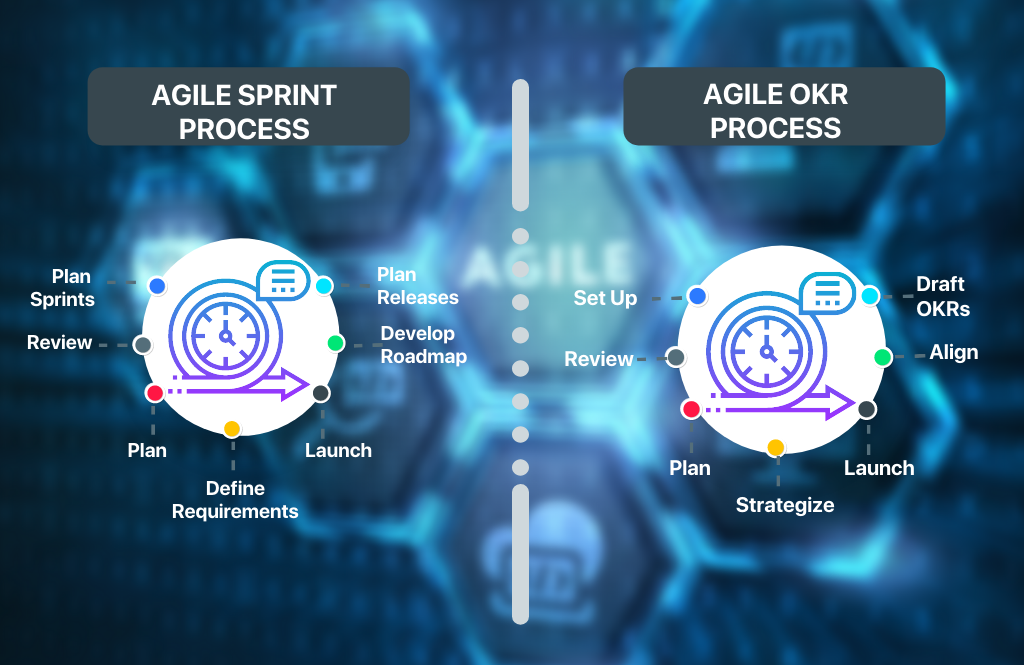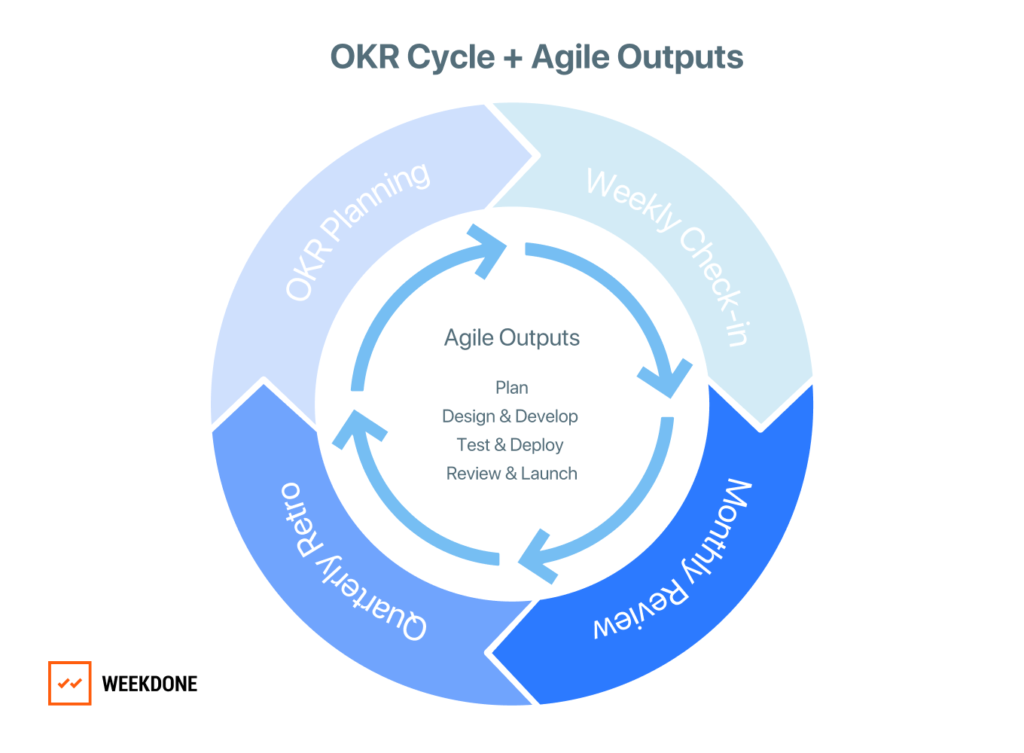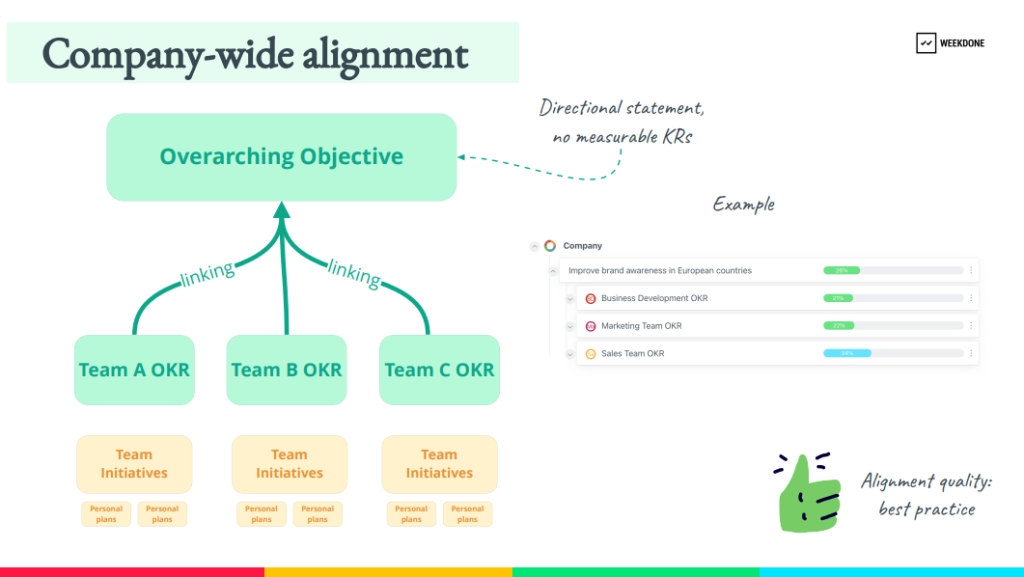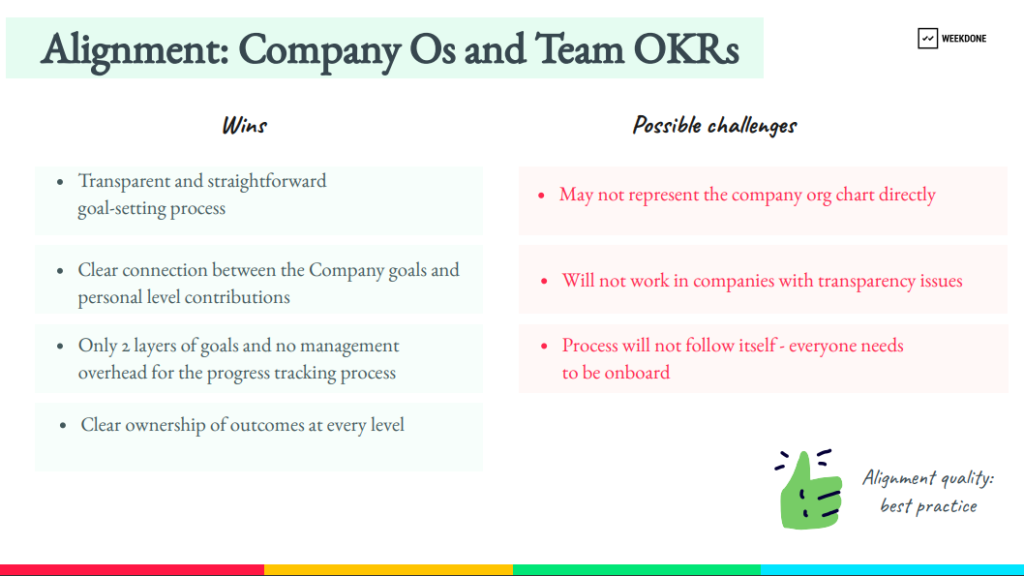If one thing that the past few years has taught us is that resilience is what helps businesses stay afloat. Black swan events – from the pandemic, and supply chain disruption, to financial unrest – have made a business environment that is challenging to navigate.
Companies that can adapt quickly, stay agile, improve operational efficiency, streamline budgeting, and align goals, have proven to be successful in building recession-proof strategies.
Nothing could be more true than the fact that “recessions favor the prepared”.
When long-term planning and forecasting are increasingly difficult to manage, what do best-in-class companies do to prepare for the recession? How are they staying resilient?
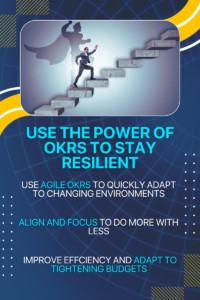
OKRs in Challenging Times: Takeaway from Intel’s Example
Remember the tough microprocessor battle between Intel and Motorola in 1979? What did Intel do? They launched “Operation Crush” – a groundbreaking marketing solution that revolutionized the way technology was promoted and perceived.
The campaign was driven by the simple premise of understanding the needs and wants of customers, the ideal solutions to their problems, and that any technology was merely a means to an end for most customers. Combined with this strategy was Andy Grove’s OKR approach that everyone in the company is responsible for achieving the goals – from the CEO to the apprentice. Operation Crush was legendary leading to Intel winning the tough microprocessor battle with Motorola.
While modern problems require modern solutions, lessons from this success story are relevant even today. The OKR framework has turned the top-down management structure inside out and revolutionized the approach to planning and setting goals.
Companies are increasingly adopting the Objectives and Key Results (OKR) framework to stay agile, aligned, and adaptable. Inspiring a goal-setting mindset, launching OKRs encourages innovative thinking, makes everyone rethink the purpose of planning, and ushers a forward-looking outlook.
👇 Find out how you can focus on what matters most when times are tough.
How OKRs Help to Stay Resilient and Recession-Proof
How OKRs help rethink strategy, execution, and delivery
1. Adopt the Agile OKR Framework
If one thing is needed in times of business uncertainty it is the ability to quickly adapt to change. Increasing agility is one of the top drivers to operate efficiently in an uncertain business environment and build recession-proof strategies.
Agility requires adopting an agile mindset. Using an iterative approach, conventional agile methodologies include collaboration, ideation, iteration, and introducing proactive initiatives.
While it has worked well to manage projects and processes, in an agile environment adaptability is a key element that requires aligning, reviewing, and updating goals regularly.

Here’s where the OKR framework plays an important role. It provides an effective way to set, align, review, and update goals at every level – from leadership to individual teams. Moreover, setting measurable Key Results gives goal setting a quantifiable measurement and purpose.
How to Launch Agile OKRs
Using agile techniques such as sprint, kanban, scrum, and lean methodologies to build OKRs can elevate your goal-setting process. The conventional agile sprint process is similar to the OKR building process and combining both is a good way to build a holistic goal strategy.
💡 Building an agile OKR framework should ideally be a sprint of 1 to 2 weeks. In that way, you and your team can build a cadence to launch, review, and improve objectives to reflect and adapt to changes.
To launch OKRs using an agile framework here are some pointers at every stage of the process to help you get started::
- Plan and Define Requirements
- Choose the scope of your OKR implementation project. It does not need to start from leadership; it could be a specific department or team
- Identify the OKR product owner, the team members who will be involved, and other stakeholders
- Develop a Strategy Roadmap
- Determine the cadence and timing of meetings for planning, discussion, and setup
- Discuss the strategy and agree on strategic priorities
- Identify committed key results from existing plans
- Take guidance from an OKR mentor to get set on the right path
- Align and Draft OKRs
- Take inspiration from the corporate-level strategy and accurately translate them to team objectives
- Identify the critical performance gaps and improvements areas to focus on to achieve the top-level strategy
- Draft outcome-based objectives
- Communicate and discuss OKRs with all team members
- Identify where you need support to achieve your objectives
- Ensure everyone is aligned to work cohesively as a team
- Identify and finalize measurable key results
- Establish a cadence of accountability and assign owners for every objective, key result, and initiative
- Create a bottom-up feedback loop to ensure that OKRs contribute to the overall corporate strategy
- Set Up, Review, and Launch
- Choose and set OKRs in a software to systemize goal setting
- Configure and customize reports and dashboards
- Identify trigger points every quarter to refresh OKRs when performance targets are achieved
- Determine the cadence of review meetings (weekly, monthly, and quarterly) and identify how to make them more effective
- Launch OKRs and create a loop of continuous improvement
The OKR Process to Stay Resilient in Trying Times
Staying resilient requires proactiveness to identify improvement areas and revamp plans accordingly. To build recession-proof strategies promptly, the OKR framework is successful because it clarifies the company vision and maintains the focus on improvement areas (objectives) and measurable outcomes (key results).
OKRs use in an agile team ensures that everyone is clear about what needs to be achieved and why it is important. Here’s how critical elements in the OKR process facilitate agility:
- The quarterly OKR cycle gives a perfect period within which improvements can be identified and made.
- Weekly Check-ins ensure that everyone is on track to achieving their objectives.
- The PPP (Plans, Progress, Problems) weekly status report system is ideal to track the progress of goals, achievements, and challenges.
- Quarterly Retrospectives are review meetings that help understand what needs to be done differently and address open questions. This can help write better OKRs for the next quarter.
The Advantages of Combining Agile and OKR Methodologies
Best-in-class companies are combining the agile and OKR frameworks because they are proven methodologies that help refine the approach to creating recession-proof strategies. What is the advantage of combining the two?
- Adapt to changes faster – Conduct weekly check-ins to determine changes required and adapt strategies accordingly.
- Identify issues sooner – Utilize regular progress reports to identify issues before they become major obstacles to growth. Fail fast, recover faster.
- Determine improvement areas quicker – Maintain a quarterly OKR cycle and conduct retrospectives to identify focus areas that need to improve.
- Direct the focus of all teams and work collaboratively – Aligning everyone to the company goals can ensure efforts are cohesive to achieve the objectives.
💡 The success of agile teams is only as good as the tools that are provided. Sharing best practices, consulting an OKR coach, and providing access to goal-setting tools can increase the adoption of agile techniques.
2. Achieve Alignment and Operational Efficiency
Strategic alignment in times of uncertainty is not only recommended but critical. When companies need to balance operational performance and cost and there is a strain on resources, operational efficiency can be achieved when all teams work cohesively and align their strategic objectives with the overarching company goal.
Aligning teams with business goals is a common challenge many companies face. To stay aligned it is important to communicate changes to the company goals and provide reasons for the shift in focus. This equips employees with the information they need to do their jobs and helps align team objectives with high-level goals.
Adopting the OKR methodology improves organizational efficiency by providing a clear framework to set goals, measure progress, and align strategy. It ensures optimal utilization of resources and company-wide alignment.
Achieve company-wide alignment in 3 simple steps:
- Create a Company Objective – A directional statement, strategic priority, or company vision typically created at the top level
- Set Team OKRs – Objectives and key results that are defined by teams and aim to achieve the Company Objective
- Link Initiatives and Weekly Check-Ins to Team OKRs – All the tasks, projects, and plans to achieve key results. Monitor progress and assess performance through weekly meetings.
Don’t Cascade OKRs – Combine Top-Down and Bottom-Up Alignment Approaches
Recession-proof strategies are invariably made at the top level. While the overall company vision needs to be defined, the top-down approach of cascading OKRs is an ineffective method. It restricts innovative thinking by not including employees in the bigger picture of strategy development.
OKRs should be created together, collaboratively. Team members and managers must take inspiration from the company OKRs to identify team OKRs that can contribute to the end goal. Managers need to validate them and ensure they are aligned with the company’s goals.
This OKR hierarchy, combining a top-down and bottom-up alignment approach, ensures objectives are set and aligned at the company, team, and individual levels.
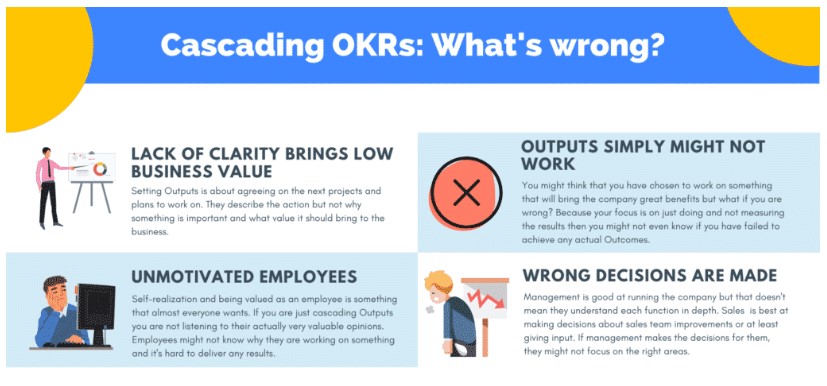
How OKRs Foster Alignment and Improve Operational Efficiency
In a dynamic business environment, executing business strategies can be challenging. Connecting the purpose to strategy and execution requires everyone in the company to be aware and work toward a shared goal. Without alignment of all functions, operations, and stakeholders, strategy execution can be ineffective.
Alignment of objectives, people, and processes is a smart approach that companies use to find prompt solutions when building recession-proof strategies. Here are some of the ways how OKRs can help:
- Stay aligned and drive effective strategy execution
- Drive company-wide focus on important improvement areas
- Save time spent on activities that do not have an impact on growth
- Improve team collaboration and resource utilization
- Create structured conversations to set priorities – and define interdependencies between teams
👇 When there’s constant change, aligning strategic goals and utilizing resources efficiently is crucial to staying on track.
3. Adapt to Go Beyond Budgeting Control
Companies take various measures to adapt to an uncertain business environment – from decreasing costs to budgeting control. One of the ways to ensure stability and stay in control is effective financial planning and budgeting.
Instead of trying to predict the unforeseeable, a better strategy would be to take an outcome-driven approach when budgeting and planning. Rather than focusing to hitting numerical targets, shifting the focus on improving outcomes (value to customers and business results for the company) can successfully drive recession-proof strategies.
Adopting the OKR framework works well to identify pivotal points at critical moments, making it easier to tackle uncertainties. While financial targets are required, adapting the budgeting process with a goal setting mindset can derive better results.
Gain Strategic Focus in Financial Planning by Adopting OKRs
Adjustments in the financial planning process are critical to being adaptable in turbulent times. What implementing OKRs does is that it urges discussions that can lead to better resource allocation and utilization. Aligning team-level objectives with strategic priorities could lead to revamping plans that are not working, but this could drive more growth opportunities.
Financial planning, budgeting, and cost optimization start from strategy. Taking a step in the right direction from the beginning of the goal-setting process is important to derive optimal results.
The Rewarding Results of Using OKRs for Budgeting and Planning
Some of the outcomes you can expect by adopting the OKR framework when developing budgeting strategies include:
- Create a concrete pre-recession plan by rethinking the approach to budgeting, focusing on the results, and identifying how to achieve them
- Plan for greater performance with outcome-driven objectives instead of output-based initiatives that gain predictable income
- Connect financial and budgeting goals with company growth
- Collaborate and develop finance OKRs aligned with the goals of other teams
- Track progress and performance using dashboards and reports to get insights into areas for cost-optimization and inform budgeting decisions
- Monitor and measure performance (KPIs) and use them as inputs to create Team OKRs
- Drive cost optimization by keeping objectives focused on reducing costs and maximizing business value
- Identify cost centers and create initiatives to find improvement areas without impacting the overall performance of the business
- Launch an iterative approach to implementing OKRs by creating a step-by-step process to connect financial planning, budgeting, and strategy execution
👉 Consider these finance OKR examples to get started on your new approach to setting goals.
Recession-Proof Your Business in 2023 with OKRs
💡 Thought leader Peter Drucker accurately noted – there is a difference between efficiency – “doing things right” and effectiveness – doing the “right things”.
Focusing on doing the right things that matter – that’s the essence of the OKR framework. As an effective outcome-driven approach to goal setting, OKRs provide the agility and alignment required to support continuous improvement. It bridges the gap between long-term goals and daily initiatives to realize the long-term vision.
In an evolving environment, a successful recession-proof strategy would be to adopt the OKR framework to imbibe an agile mindset and nurture an adaptable culture. With change being constant and as the fears of recession impede growth, the formula for success is taking a strategic approach to goal setting – one that will drive resilience in tough times.
💡 Turning the tide on recession is not possible without radical change. Drive resilience using a strategic approach to planning, goal-setting, and success.
